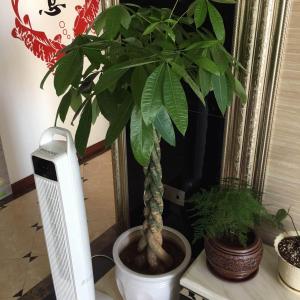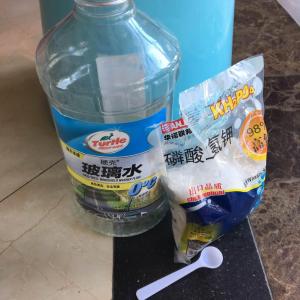文章
Dummer. ゛☀
2017年07月23日

Family - Nyctaginaceae
Stems - To 1m tall, erect to ascending, dichotomously branching, multiple from the base, glabrous or with some minute pubescence at the nodes, often glaucous, 4-angled (the angles rounded), often reddish at the nodes.

Leaves - Opposite, petiolate. Blades truncate to subtruncate at the base, acute at the apex, ovate to lanceolate, typically glabrous but with a few hairs near the petiole, to +10cm long, +7cm broad. Margins with some cilia or a few strigose hairs.
Inflorescence - Terminal cymose clusters of multiple flowers. Pedicels and branches of the cyme with dense antrorse pubescence. Pedicels to +1.5cm long.


Flowering - May - October.
Habitat - Open ground, prairies, waste ground, roadsides, railroads.
Origin - Native to U.S.
Other info. - This showy yet weedy species can be found throughout Missouri. The flowers of this species typically open for about one or two hours per day and then close and drop. The plant is most often seen with closed flowers or, more commonly, in fruit. Despite the short flowering time, this is the most showy species of the genus in Missouri.
Traditionally the plant (root tea) was used to treat fevers and to expel internal parasites. A poultice was applied externally to burns, sores, and swelling. The plant is considered to be toxic and should not be ingested.
Stems - To 1m tall, erect to ascending, dichotomously branching, multiple from the base, glabrous or with some minute pubescence at the nodes, often glaucous, 4-angled (the angles rounded), often reddish at the nodes.

Leaves - Opposite, petiolate. Blades truncate to subtruncate at the base, acute at the apex, ovate to lanceolate, typically glabrous but with a few hairs near the petiole, to +10cm long, +7cm broad. Margins with some cilia or a few strigose hairs.
Inflorescence - Terminal cymose clusters of multiple flowers. Pedicels and branches of the cyme with dense antrorse pubescence. Pedicels to +1.5cm long.


Flowering - May - October.
Habitat - Open ground, prairies, waste ground, roadsides, railroads.
Origin - Native to U.S.
Other info. - This showy yet weedy species can be found throughout Missouri. The flowers of this species typically open for about one or two hours per day and then close and drop. The plant is most often seen with closed flowers or, more commonly, in fruit. Despite the short flowering time, this is the most showy species of the genus in Missouri.
Traditionally the plant (root tea) was used to treat fevers and to expel internal parasites. A poultice was applied externally to burns, sores, and swelling. The plant is considered to be toxic and should not be ingested.
0
0
文章
Colour_
2017年07月23日

盆栽火龙果的养殖方法

1、将火龙果挖出果肉
2、加入清水泡一天
3、装入丝袜里,反复冲洗捏挤
4、再仔细冲洗,直到火龙果种子沉入容器的底部
5、沥干水分
6、将底部没有的孔的容器下部铺上10公分高的一层小石子,上面填好无菌土壤
7、撒上火龙果种子,喷洒适量水
8、 盖上一层膜密封,每天将膜敞开透透气,然后再盖上,一个星期后长出很多芽来

火龙果盆栽种植养护
1.火龙果种子的最佳发芽温度是25度左右。
2.一个中等大小的火龙果的种子,至少可以制作10盆这样的小盆栽,按照自己的需要来取用种子就好了。
3.要选择颗粒比较幼细的培养土,也可以用市售的播种土代替。
4.一定要将附在种子上的果肉和胶质清除干净,否则发芽时易长霉菌。
5.做造型小盆栽,种子要铺得密一些,尤其是边缘的部分,否则种出来稀稀松松,会失去美感。
6.因为杯子没有底孔,所以不要用水壶直接浇水以免浇水过量,2-3天用喷壶喷一次就可以了。

1、将火龙果挖出果肉
2、加入清水泡一天
3、装入丝袜里,反复冲洗捏挤
4、再仔细冲洗,直到火龙果种子沉入容器的底部
5、沥干水分
6、将底部没有的孔的容器下部铺上10公分高的一层小石子,上面填好无菌土壤
7、撒上火龙果种子,喷洒适量水
8、 盖上一层膜密封,每天将膜敞开透透气,然后再盖上,一个星期后长出很多芽来

火龙果盆栽种植养护
1.火龙果种子的最佳发芽温度是25度左右。
2.一个中等大小的火龙果的种子,至少可以制作10盆这样的小盆栽,按照自己的需要来取用种子就好了。
3.要选择颗粒比较幼细的培养土,也可以用市售的播种土代替。
4.一定要将附在种子上的果肉和胶质清除干净,否则发芽时易长霉菌。
5.做造型小盆栽,种子要铺得密一些,尤其是边缘的部分,否则种出来稀稀松松,会失去美感。
6.因为杯子没有底孔,所以不要用水壶直接浇水以免浇水过量,2-3天用喷壶喷一次就可以了。
1
0
文章
权问薇
2017年07月23日


腰果的栽培方法及注意事项
压条
腰果的压条育苗时间每年可以有两个时期,一个是2-4月,另一个是10-11月,在这两个时间段内压条的成果率高达93%。压条母株最适合选择10龄以下的母株,如果母株的年龄过高,超过20龄,即使压条成功也很难生根。压条通常采用泥炭、刨花和苔藓等材料。
组织培养
在附加0.5毫克/升的IAA和0.5毫克/升的激动素的培养基上培养的子叶外殖体可直接形成器官,大约5周时间就可以形成完整的植株。不需要进行培养和诱导。
整形修剪
对腰果树进行整形修剪可以提高坐果率、加强树体的通风和透光。整形修剪通常遵循宜轻不宜重、宜早不宜迟的原则。可以分期多批次的进行修剪,这样的效果会更好。
注意事项
腰果树从栽培到结出果实,这一个漫长的生长阶段会遭受几十种病虫的威胁。比如:流胶病、
黄色叶斑病、叶腐病等。如果腰果树上出现了例如金龟子、腰果细蛾等害虫的身影,一定要及时喷农药哦!
0
0
文章
我家狗狗会尖叫
2017年07月23日

萱草以分株繁殖为主,春、秋季均可进行,但以春季为主。分株后夏季就可以开花。每年2〜3月挖取地下宿根,剪去枯根及过多的须根,3〜5芽分栽一盆。露地栽植的株行距0.5-0.8m,每穴种植4〜5株。穴内先放堆肥盖上细土,再将植株栽于穴内。种植不宜太深,土壅至根颈处即可。种植时注意不要损坏叶芽,栽后施足水分。人冬前施腐熟堆肥一次,生长期按一般肥水管理进行。一般3~5年分株一次。盆栽结合分株每年换盆一次。

繁殖方法
繁殖方法以分株繁殖为主,育种时用播种繁殖。分株繁殖于叶枯萎后或早春萌发前进行,将根株掘起剪去枯根及过多的须根,分株即可。一次分株后可4~5年后再分株,分株苗当年即可开花。种子繁殖宜秋播,一般播后4星期左右出苗。夏秋种子采下后如立即播种,20天左右出苗。播种苗培育2年后开花。
栽培管理
栽培管理简单粗放,株行距0.5×1米左右,每穴栽3~5株。栽前施足基肥。由于萱草适应性强,几乎随处可种,任其生长,株丛可年年不断扩大,但在庭园配植时应按株高和花色进行搭配,以提高观赏效果。
栽培要点
喜温暖湿润环境。土壤以稍带粘性较好。可在田坎、水沟边、住宅旁等处栽培。分株繁殖。10~11月地上部枯萎后或春季植株未萌芽前,挖起全株,每2、3等分为一丛。
栽前,按行、株距各40cm开穴,穴深17~20cm,每穴栽一丛,根要向四面平铺,盖土压紧。浇水或灌浇人畜粪水。自第二年起,每年中耕除草和追肥3次,第一次在3月出苗时,第二次在6月开花前,第三次在10月倒苗后,每次中耕除草后,施用人畜粪水。
病虫害防治
萱草常见的病害有叶斑病、叶枯病、锈病、炭疽病和茎枯病等:虫害主要有红蜘蛛、蚜虫、蓟马、潜叶蝇等。
防治病虫害:首先要搞好农业防治,在黄花菜采摘完后,地上部随即枯死,应及时割蔸并运离黄花菜地外,以减少菌源、虫源;搞好黄花菜的追肥、冬培工作,以增强抗病能力;适时更新复壮老蔸;选用抗病品种等。适时用药防治,病害可用75%的百菌清800倍液喷雾防治,虫害可用艾美乐3000倍喷雾防治。
萱草也可播种繁殖,种子随采随播,次春出芽,如在下年春播,当年不能发芽出苗。萱草易遭蚜虫为害,喷40%氧化乐果1500倍液防治。

繁殖方法
繁殖方法以分株繁殖为主,育种时用播种繁殖。分株繁殖于叶枯萎后或早春萌发前进行,将根株掘起剪去枯根及过多的须根,分株即可。一次分株后可4~5年后再分株,分株苗当年即可开花。种子繁殖宜秋播,一般播后4星期左右出苗。夏秋种子采下后如立即播种,20天左右出苗。播种苗培育2年后开花。
栽培管理
栽培管理简单粗放,株行距0.5×1米左右,每穴栽3~5株。栽前施足基肥。由于萱草适应性强,几乎随处可种,任其生长,株丛可年年不断扩大,但在庭园配植时应按株高和花色进行搭配,以提高观赏效果。
栽培要点
喜温暖湿润环境。土壤以稍带粘性较好。可在田坎、水沟边、住宅旁等处栽培。分株繁殖。10~11月地上部枯萎后或春季植株未萌芽前,挖起全株,每2、3等分为一丛。
栽前,按行、株距各40cm开穴,穴深17~20cm,每穴栽一丛,根要向四面平铺,盖土压紧。浇水或灌浇人畜粪水。自第二年起,每年中耕除草和追肥3次,第一次在3月出苗时,第二次在6月开花前,第三次在10月倒苗后,每次中耕除草后,施用人畜粪水。
病虫害防治
萱草常见的病害有叶斑病、叶枯病、锈病、炭疽病和茎枯病等:虫害主要有红蜘蛛、蚜虫、蓟马、潜叶蝇等。
防治病虫害:首先要搞好农业防治,在黄花菜采摘完后,地上部随即枯死,应及时割蔸并运离黄花菜地外,以减少菌源、虫源;搞好黄花菜的追肥、冬培工作,以增强抗病能力;适时更新复壮老蔸;选用抗病品种等。适时用药防治,病害可用75%的百菌清800倍液喷雾防治,虫害可用艾美乐3000倍喷雾防治。
萱草也可播种繁殖,种子随采随播,次春出芽,如在下年春播,当年不能发芽出苗。萱草易遭蚜虫为害,喷40%氧化乐果1500倍液防治。
0
1
文章
Dummer. ゛☀
2017年07月23日

Family - Lythraceae
Stems - Multiple from base, becoming woody at the base, herbaceous above, to 2m tall, 4-angled, scabrous, pubescent to hispidulous, erect.

Leaves - Opposite to subopposite in inflorescence, linear-lanceolate to oblong-linear, sessile, somewhat clasping or not, entire, scabrous, +/-10cm long, +/-2cm broad, acute, reduced upward, greatly reduced in inflorescence to foliaceous bracts.

Inflorescence - Dense terminal spikes with clusters of 3-9 flowers per node. Flowers subtended by reduced leaf(foliaceous bract). Bracts dense pubescent. Axis of inflorescence dense pubescent to tomentose.
Flowers - Petals 5, borne at apex of floral tube, to 7mm long, 3.5mm broad, glabrous, subequal, oblong-obovate, pinkish-rose. Stamens 10-12, in two sets of five or six each. Longer set of stamens well exserted. Filaments to 1.3cm long, adnate at base of floral tube. Anthers purple. Shorter set of stamens included to slightly exserted. Filaments white and fading to pinkish-purple at apex. Anthers yellow. Ovary cylindrical-conic, 2.5mm long, 1mm in diameter, glabrous. Style 1mm long, curved. Stigma glandular, capitate, green. Floral tube to 7mm long, 3mm in diameter, cylindric, 12-nerved, dense pubescent, with 6 appendages. Appendages linear-attenuate, 2-3mm long, greenish, alternating with calyx lobes. Calyx lobes pink, to 1mm long, shorter than appendages, acute.

Flowering - June - September.
Habitat - Moist to wet ground along ditches, streambanks, meadows, waste ground, prairies, roadsides, railroads. Also cultivated.
Origin - Native to Europe.
Other info. - Efforts to keep this plant under control in Missouri so far have met with moderate success. The plant is rare in the wild and typically gets destroyed upon its discovery. You can help too. If you find the plant in the wild, report its location to Missouri Department of Conservation. This is no laughing matter as anyone who has been to New England or the Northeast can attest. The plant is highly invasive and can quickly spread through an area and out-compete all native flora. It creates a sea of pink which may be pretty to look at but is an environmental disaster. Don't be tempted to grow it at home, find something else.
Stems - Multiple from base, becoming woody at the base, herbaceous above, to 2m tall, 4-angled, scabrous, pubescent to hispidulous, erect.

Leaves - Opposite to subopposite in inflorescence, linear-lanceolate to oblong-linear, sessile, somewhat clasping or not, entire, scabrous, +/-10cm long, +/-2cm broad, acute, reduced upward, greatly reduced in inflorescence to foliaceous bracts.

Inflorescence - Dense terminal spikes with clusters of 3-9 flowers per node. Flowers subtended by reduced leaf(foliaceous bract). Bracts dense pubescent. Axis of inflorescence dense pubescent to tomentose.
Flowers - Petals 5, borne at apex of floral tube, to 7mm long, 3.5mm broad, glabrous, subequal, oblong-obovate, pinkish-rose. Stamens 10-12, in two sets of five or six each. Longer set of stamens well exserted. Filaments to 1.3cm long, adnate at base of floral tube. Anthers purple. Shorter set of stamens included to slightly exserted. Filaments white and fading to pinkish-purple at apex. Anthers yellow. Ovary cylindrical-conic, 2.5mm long, 1mm in diameter, glabrous. Style 1mm long, curved. Stigma glandular, capitate, green. Floral tube to 7mm long, 3mm in diameter, cylindric, 12-nerved, dense pubescent, with 6 appendages. Appendages linear-attenuate, 2-3mm long, greenish, alternating with calyx lobes. Calyx lobes pink, to 1mm long, shorter than appendages, acute.

Flowering - June - September.
Habitat - Moist to wet ground along ditches, streambanks, meadows, waste ground, prairies, roadsides, railroads. Also cultivated.
Origin - Native to Europe.
Other info. - Efforts to keep this plant under control in Missouri so far have met with moderate success. The plant is rare in the wild and typically gets destroyed upon its discovery. You can help too. If you find the plant in the wild, report its location to Missouri Department of Conservation. This is no laughing matter as anyone who has been to New England or the Northeast can attest. The plant is highly invasive and can quickly spread through an area and out-compete all native flora. It creates a sea of pink which may be pretty to look at but is an environmental disaster. Don't be tempted to grow it at home, find something else.
0
0
文章
Dummer. ゛☀
2017年07月23日

Family - Lythraceae
Stems - To +1m tall, erect, herbaceous to woody below, 4-angled, branching above, glabrous. Angles slightly winged.

Leaves - Mainly opposite to subopposite or with some alternate near apex, sessile, oblong, entire, acute, glabrous, to 5cm long, +1cm broad. Margins sparse stigillose.

Inflorescence - Single or paired flowers from leaf axils in upper portion of stems. Leaves greatly reduced in inflorescence to small bracts. Flowering portion of stem to +25cm long. Pedicles -1mm long, with two minute opposite bracts.
Flowers - Petals 6, pinkish-purple or rose-pink, 5mm long, 2.2mm broad, borne at edge of floral tube, with purple midvein. Stamens 6, unequal, adnate about 1/2 way up floral tube, included. Filaments glabrous, 5mm long, purplish. Anthers purple, .2mm broad. Style glabrous, white, exserted. Stigma globose-capitate, greenish. Floral tube to 6mm long, 1.1mm in diameter, glabrous, 12-nerved, with 6 appendages. Appendages alternating with calyx lobes, linear, to 1mm long, spreading. Calyx lobes acute, .5mm long, triangular.

Flowering - May - September.
Habitat - Wet meadows and prairies, open wet glades, fens, stream and pond margins, railroads.
Origin - Native to U.S.
Other info. - This species can be found throughout Missouri but is mostly absent from the bootheel portion of the state. The plant has both alternate and opposite leaves. It can be easily identified by its pinkish-purple flowers, winged stems, and habitat.
This is the native and good member of the genus Lythrum represented in Missouri. We also have the dreaded L. salicaria L.which is nothing short of a noxious weed. Both plants are striking but only L. alatum belongs. It can make a good garden subject for moist or wet areas.
Stems - To +1m tall, erect, herbaceous to woody below, 4-angled, branching above, glabrous. Angles slightly winged.

Leaves - Mainly opposite to subopposite or with some alternate near apex, sessile, oblong, entire, acute, glabrous, to 5cm long, +1cm broad. Margins sparse stigillose.

Inflorescence - Single or paired flowers from leaf axils in upper portion of stems. Leaves greatly reduced in inflorescence to small bracts. Flowering portion of stem to +25cm long. Pedicles -1mm long, with two minute opposite bracts.
Flowers - Petals 6, pinkish-purple or rose-pink, 5mm long, 2.2mm broad, borne at edge of floral tube, with purple midvein. Stamens 6, unequal, adnate about 1/2 way up floral tube, included. Filaments glabrous, 5mm long, purplish. Anthers purple, .2mm broad. Style glabrous, white, exserted. Stigma globose-capitate, greenish. Floral tube to 6mm long, 1.1mm in diameter, glabrous, 12-nerved, with 6 appendages. Appendages alternating with calyx lobes, linear, to 1mm long, spreading. Calyx lobes acute, .5mm long, triangular.

Flowering - May - September.
Habitat - Wet meadows and prairies, open wet glades, fens, stream and pond margins, railroads.
Origin - Native to U.S.
Other info. - This species can be found throughout Missouri but is mostly absent from the bootheel portion of the state. The plant has both alternate and opposite leaves. It can be easily identified by its pinkish-purple flowers, winged stems, and habitat.
This is the native and good member of the genus Lythrum represented in Missouri. We also have the dreaded L. salicaria L.which is nothing short of a noxious weed. Both plants are striking but only L. alatum belongs. It can make a good garden subject for moist or wet areas.
0
0
文章
Dummer. ゛☀
2017年07月23日

Family - Lamiaceae
Stems - To +1.2m tall, herbaceous, multiple, rhizomatous, simple to branching above, minutely retrorse pubescent on angles, strongly 4-angled, hollow.
Leaves - Opposite, petiolate, 3-lobed, hirsute below (mostly on veins), pubescent above, reduced upward. Lowest leaves to +15cm broad, +12cm long. Lobes again divided or coarsely toothed. Petioles to +13cm long, 4-angled, densely pubescent and hirsute on upper margins (angles).

Inflorescence - Axillary clusters of 11-12 sessile flowers almost completely surrounding stem and appearing as verticillasters (whorls).

Flowers - Corolla bilabiate, tubular, constricted near base, densely pubescent to lanate externally, lanate near apex of throat internally, pinkish. Tube to 6mm long, 2.2mm in diameter. Lower lip reduced, 3-lobed. Lateral lobes small (-1mm long), recurved and folding under central lobe. Central lobe to 2mm long, attenuate, deflexed or slightly recurving, mottled with maroon near apex of throat. Upper lip 5-6mm long, +/-3mm broad, densely lanate above, obtuse, pink. Stamens 4, didynamous, slightly exserted beyond upper lip. Filaments white, to 1.6mm long, lanate (at least at base). Style 1, glabrous, positioned between upper pair of stamens. Stigma 2-lobed. Nutlets 4, densely hirsute at apex. Calyx bilabiate, with 5 ridges (nerves). Tube to 4mm long, glabrous. Upper lip with 3 lobes. Lobes attenuate, to 2mm long, spinose, with few hairs near apex. Lower lip 2-lobed. Lobes attenuate, 2.1mm long, deflexed or slightly recurved, spinose, with few hairs near apex.

Flowering - May - August.
Habitat - Pastures, waste ground, disturbed sites, roadsides, railroads.
Origin - Native to Eurasia.
Other info. - ...So I'm driving home and I spot a good planting of Delphinium ajacis. I decided to stop and take some snaps. Upon returning to my car I reached for my keys only to discover them still in my ignition and behind locked doors. The passenger window was cracked open a bit so I decided to look for some wire and fish my keys out. As I walked around an abandoned building I found not only some good wire, but also the plant pictured above. The moral of the story? - Always have a spare set of keys handy and ALWAYS have your camera.
Stems - To +1.2m tall, herbaceous, multiple, rhizomatous, simple to branching above, minutely retrorse pubescent on angles, strongly 4-angled, hollow.
Leaves - Opposite, petiolate, 3-lobed, hirsute below (mostly on veins), pubescent above, reduced upward. Lowest leaves to +15cm broad, +12cm long. Lobes again divided or coarsely toothed. Petioles to +13cm long, 4-angled, densely pubescent and hirsute on upper margins (angles).

Inflorescence - Axillary clusters of 11-12 sessile flowers almost completely surrounding stem and appearing as verticillasters (whorls).

Flowers - Corolla bilabiate, tubular, constricted near base, densely pubescent to lanate externally, lanate near apex of throat internally, pinkish. Tube to 6mm long, 2.2mm in diameter. Lower lip reduced, 3-lobed. Lateral lobes small (-1mm long), recurved and folding under central lobe. Central lobe to 2mm long, attenuate, deflexed or slightly recurving, mottled with maroon near apex of throat. Upper lip 5-6mm long, +/-3mm broad, densely lanate above, obtuse, pink. Stamens 4, didynamous, slightly exserted beyond upper lip. Filaments white, to 1.6mm long, lanate (at least at base). Style 1, glabrous, positioned between upper pair of stamens. Stigma 2-lobed. Nutlets 4, densely hirsute at apex. Calyx bilabiate, with 5 ridges (nerves). Tube to 4mm long, glabrous. Upper lip with 3 lobes. Lobes attenuate, to 2mm long, spinose, with few hairs near apex. Lower lip 2-lobed. Lobes attenuate, 2.1mm long, deflexed or slightly recurved, spinose, with few hairs near apex.

Flowering - May - August.
Habitat - Pastures, waste ground, disturbed sites, roadsides, railroads.
Origin - Native to Eurasia.
Other info. - ...So I'm driving home and I spot a good planting of Delphinium ajacis. I decided to stop and take some snaps. Upon returning to my car I reached for my keys only to discover them still in my ignition and behind locked doors. The passenger window was cracked open a bit so I decided to look for some wire and fish my keys out. As I walked around an abandoned building I found not only some good wire, but also the plant pictured above. The moral of the story? - Always have a spare set of keys handy and ALWAYS have your camera.
0
0
文章
Dummer. ゛☀
2017年07月23日

Family - Lamiaceae
Stems - To +20cm tall, decumbent at base to erect, multiple from fibrous roots, herbaceous, hollow, 4-angled, minutely retrorse strigillose on angles.
Leaves - Opposite, decussate, petiolate. Lowest leaves with petioles to +/-3cm long. Petioles ciliate. Blades cordate to reniform, crenate-serrate, pubescent. Upper leaves becoming triangular and acute, to 3cm long and broad.

Inflorescence - Dense verticillasters near the apex of the stems. Cymules typically 3-flowered. Leaves (bracts) subtended verticillasters typically with a dark purple stripe. Flowers sessile.

Flowers - Corolla bilabiate, to 1.5cm long, expanded near apex, glabrous internally. Contracted portion of tube typically +/-5mm long, glabrous. Upper lip galeate, pinkish externally, villous externally, 5mm long, 3-4mm broad. Lower lip from expanded portion of tube. Lateral lobes minute, 1mm long, linear-subulate, pink. Central lobe obcordate, reflexed, 2-3mm long, pink with darker spots at base. Stamens 4, didynamous, adnate near middle of corolla tube, included under galea. Filaments white, to 6mm long, glabrous. Anthers brownish, +1mm long, with some white floccose pubescence. Ovary 4-lobed. Lobes truncate at apex, wedge shaped in cross section and trigonous, glabrous, olive-green, .5mm long. Calyx tube 3mm long, 5-toothed, mostly glabrous, whitish-green with purple ribs. Teeth attenuate, ciliate and glandular pubescent, 3mm long. Calyx accrescent. Nutlets to +2mm long, glabrous.

Flowering - April - October.
Habitat - Waste ground, thickets, roadsides, railroads.
Origin - Native to Eurasia.
Other info. - Although this may be an attractive little plant to look at, it should not be willingly spread as it is very invasive. This plant is becoming common throughout Missouri and is seen in its best condition during the months of April and May. If left undisturbed, the plant can form large colonies.
Stems - To +20cm tall, decumbent at base to erect, multiple from fibrous roots, herbaceous, hollow, 4-angled, minutely retrorse strigillose on angles.
Leaves - Opposite, decussate, petiolate. Lowest leaves with petioles to +/-3cm long. Petioles ciliate. Blades cordate to reniform, crenate-serrate, pubescent. Upper leaves becoming triangular and acute, to 3cm long and broad.

Inflorescence - Dense verticillasters near the apex of the stems. Cymules typically 3-flowered. Leaves (bracts) subtended verticillasters typically with a dark purple stripe. Flowers sessile.

Flowers - Corolla bilabiate, to 1.5cm long, expanded near apex, glabrous internally. Contracted portion of tube typically +/-5mm long, glabrous. Upper lip galeate, pinkish externally, villous externally, 5mm long, 3-4mm broad. Lower lip from expanded portion of tube. Lateral lobes minute, 1mm long, linear-subulate, pink. Central lobe obcordate, reflexed, 2-3mm long, pink with darker spots at base. Stamens 4, didynamous, adnate near middle of corolla tube, included under galea. Filaments white, to 6mm long, glabrous. Anthers brownish, +1mm long, with some white floccose pubescence. Ovary 4-lobed. Lobes truncate at apex, wedge shaped in cross section and trigonous, glabrous, olive-green, .5mm long. Calyx tube 3mm long, 5-toothed, mostly glabrous, whitish-green with purple ribs. Teeth attenuate, ciliate and glandular pubescent, 3mm long. Calyx accrescent. Nutlets to +2mm long, glabrous.

Flowering - April - October.
Habitat - Waste ground, thickets, roadsides, railroads.
Origin - Native to Eurasia.
Other info. - Although this may be an attractive little plant to look at, it should not be willingly spread as it is very invasive. This plant is becoming common throughout Missouri and is seen in its best condition during the months of April and May. If left undisturbed, the plant can form large colonies.
0
0
文章
Dummer. ゛☀
2017年07月23日

Family - Lamiaceae
Stems - From a taproot, multiple from base, ascending to erect, to +20cm tall, purplish basally, greenish above, 4-angled, hollow, scabrous from retrorse strigillose pubescence.
Leaves - Opposite, lowest leaves petiolate. Petioles to -2cm long, with a few pilose hairs and some retrorse strigillose pubescence. Blades typically +/-5-lobed, to +2cm long and broad, rotund to reniform, pubescent, with reddish margins. Margins crenate. Upper leaves reduced to bracts.

Inflorescence - Verticillasters in the apical 1/2 of the stem. Cymules with 4-5 flowers each. Clusters bracteate. Bracts sessile, 5-7-lobed, often purplish, pubescent.

Flowers - Corolla bilabiate, pale pink to purplish, to -2cm long. Corolla tube to 1.2cm long, pubescent externally and internally. Upper lip of corolla galeate, 4-5mm long and broad, pubescent externally. Lower lip saccate, with 2 small appendages at apex. Appendages 2-3mm long. Stamens 4, didynamous, adnate near base of lower lip, included under the galea. Filaments white, 4-5mm long, slightly pubescent near the base. Anthers purplish, -1mm long. Style 1.8cm long, white, glabrous. Stigma 2-lobed. Ovary 4-parted, light green, 1.7mm long, glabrous. Divisions of ovary shaped like pie-pieces when viewed from above. Nutlets brown, 2mm long, glabrous. Calyx sericeous externally, glabrous internally, accrescent, 5-toothed. Calyx tube to 2mm long in flower. Teeth 2.2mm long in flower, acute.

Flowering - February - November.
Habitat - Waste ground, lawns, cultivated fields, pastures, roadsides, railroads.
Origin - Native to Eurasia and Africa.
Other info. - This aggressive little plant has spread throughout Missouri and nearly all of North America. The plant is tolerant of sun or shade, heat or cold. In cultivated areas that get tilled regularly, the plant can form large seas of pink in the spring. The plant can grow from small pieces of its stem so chopping the plant only helps it spread. It also grows well from seed.
Stems - From a taproot, multiple from base, ascending to erect, to +20cm tall, purplish basally, greenish above, 4-angled, hollow, scabrous from retrorse strigillose pubescence.
Leaves - Opposite, lowest leaves petiolate. Petioles to -2cm long, with a few pilose hairs and some retrorse strigillose pubescence. Blades typically +/-5-lobed, to +2cm long and broad, rotund to reniform, pubescent, with reddish margins. Margins crenate. Upper leaves reduced to bracts.

Inflorescence - Verticillasters in the apical 1/2 of the stem. Cymules with 4-5 flowers each. Clusters bracteate. Bracts sessile, 5-7-lobed, often purplish, pubescent.

Flowers - Corolla bilabiate, pale pink to purplish, to -2cm long. Corolla tube to 1.2cm long, pubescent externally and internally. Upper lip of corolla galeate, 4-5mm long and broad, pubescent externally. Lower lip saccate, with 2 small appendages at apex. Appendages 2-3mm long. Stamens 4, didynamous, adnate near base of lower lip, included under the galea. Filaments white, 4-5mm long, slightly pubescent near the base. Anthers purplish, -1mm long. Style 1.8cm long, white, glabrous. Stigma 2-lobed. Ovary 4-parted, light green, 1.7mm long, glabrous. Divisions of ovary shaped like pie-pieces when viewed from above. Nutlets brown, 2mm long, glabrous. Calyx sericeous externally, glabrous internally, accrescent, 5-toothed. Calyx tube to 2mm long in flower. Teeth 2.2mm long in flower, acute.

Flowering - February - November.
Habitat - Waste ground, lawns, cultivated fields, pastures, roadsides, railroads.
Origin - Native to Eurasia and Africa.
Other info. - This aggressive little plant has spread throughout Missouri and nearly all of North America. The plant is tolerant of sun or shade, heat or cold. In cultivated areas that get tilled regularly, the plant can form large seas of pink in the spring. The plant can grow from small pieces of its stem so chopping the plant only helps it spread. It also grows well from seed.
0
0
文章
Dummer. ゛☀
2017年07月23日

Family - Rubiaceae
Stems - Multiple from fibrous roots or small caudex, to 25cm tall, simple or branching above, herbaceous, 4-angled, glabrous, often reddish below.

Leaves - Basal leaves petiolate. Petioles to +1cm long. Blades oblong to spatulate or lanceolate, tapering at base, glabrous, reddish below, green above. Cauline leaves sessile, opposite, 3cm long, +/-5mm broad, antrorse strigose, entire, linear to narrowly oblong. Opposing leaves joined at base by whitish stipule. Stipule 3mm long, 2mm broad, triangular, with few coarse purplish teeth on margins or entire.

Inflorescence - Loose cymes of +/-3 flowers terminating stems. Pedicels to 4mm long, -1mm in diameter, appearing glabrous but heavily glandular (need lens to see).
Flowers - Corolla pinkish to white, funnelform, , 4-lobed, glabrous externally, to 7mm long. Lobes 2mm long and broad, acute or minutely mucronate (mucronulate), pubescent internally, distinctly one-nerved. Stamens 4, adnate near base of corolla tube. Anthers pale-yellow, -1mm long. Filaments very short (.1mm long). Style filiform, glabrous, 6-7mm long, slightly exserted. Stigmas 2, globose. Hypanthium 1mm long. Calyx lobes to 3mm long, glabrous, entire, subulate. Fruit globose, to -3mm in diameter.

Flowering - April - July.
Habitat - Rocky open woods, prairies, glades, bluff ledges.
Origin - Native to U.S.
Other info. - In Missouri this little plant can basically be found in all counties east of a line drawn from Barton County to Callaway County. The plant is common in the parts of the state where it grows.
H. longifolia is most common on acid soils whereas the similar H. nigricans (Lam.) Fern. is more typically found on basic substrata.
A common synonym is Hedyotis longifolia (Gaertn.) Hook.
Stems - Multiple from fibrous roots or small caudex, to 25cm tall, simple or branching above, herbaceous, 4-angled, glabrous, often reddish below.

Leaves - Basal leaves petiolate. Petioles to +1cm long. Blades oblong to spatulate or lanceolate, tapering at base, glabrous, reddish below, green above. Cauline leaves sessile, opposite, 3cm long, +/-5mm broad, antrorse strigose, entire, linear to narrowly oblong. Opposing leaves joined at base by whitish stipule. Stipule 3mm long, 2mm broad, triangular, with few coarse purplish teeth on margins or entire.

Inflorescence - Loose cymes of +/-3 flowers terminating stems. Pedicels to 4mm long, -1mm in diameter, appearing glabrous but heavily glandular (need lens to see).
Flowers - Corolla pinkish to white, funnelform, , 4-lobed, glabrous externally, to 7mm long. Lobes 2mm long and broad, acute or minutely mucronate (mucronulate), pubescent internally, distinctly one-nerved. Stamens 4, adnate near base of corolla tube. Anthers pale-yellow, -1mm long. Filaments very short (.1mm long). Style filiform, glabrous, 6-7mm long, slightly exserted. Stigmas 2, globose. Hypanthium 1mm long. Calyx lobes to 3mm long, glabrous, entire, subulate. Fruit globose, to -3mm in diameter.

Flowering - April - July.
Habitat - Rocky open woods, prairies, glades, bluff ledges.
Origin - Native to U.S.
Other info. - In Missouri this little plant can basically be found in all counties east of a line drawn from Barton County to Callaway County. The plant is common in the parts of the state where it grows.
H. longifolia is most common on acid soils whereas the similar H. nigricans (Lam.) Fern. is more typically found on basic substrata.
A common synonym is Hedyotis longifolia (Gaertn.) Hook.
0
0
文章
Dummer. ゛☀
2017年07月18日

Family - Brassicaceae
Stems - To -1m tall, erect, herbaceous, branching in he apical 1/3, hispid in the basal 1/4, glabrous and glaucous above, from a big taproot, purplish at the nodes or not, slightly angled from decurrent petiole tissue.

Leaves - Alternate, petiolate, odd-pinnatifid. Lowest leaves with the rachis sparse hispid, petioles purplish at the base, green and glabrous apically. Divisions of the lower leaves +/-9 per side, subulate-lanceolate, coarsely toothed or not, hispidulous, often involute, 1-1.5cm long, +/-5mm broad, thinner near the base of the leaf. Terminal divisions broader than the laterals, not folded. All divisions acute. Upper cauline leaves reduced towards the apex. Divisions of the upper leaves linear, involute, glabrous, many with smaller divisions at their bases, to +2.5cm long, +/-1mm broad, acute, entire. Rachis of upper leaves glabrous to sparse hispidulous.

Inflorescence - Terminal and lateral racemes to +/-15cm long, compact in flower, elongating quickly in fruit, axis glabrous. Pedicels 7-8mm long in flower, to 1cm long and thickened in fruit, glabrous.
Flowers - Petals 4, spreading in the apical 1/2, white to yellow, spatulate, rounded at the apex, glabrous, tapering to a clawed base, 1cm long, 2-3mm broad at the apex. Stamens 6 (4 larger, 2 smaller), erect, exserted. Filaments to 5mm long, glabrous, translucent-white. Anthers -2mm long, erect and then spreading at dehiscence. Ovary cylindric, green, glabrous, to 6mm long in flower, superior, erect. Style wanting. Stigma capitate, two-lobed, 1.1mm broad. Sepals 4, spreading to erect, linear, 5-6mm long, involute, 1.3mm broad, glabrous, rounded and scarious at the apex, green. Fruits ascending, glabrous, to +/-8cm long, 1.1mm broad, angled, falcate, with a capitate (old stigma) apex.

Flowering - April - August.
Habitat - Fields, pastures, roadsides, railroads, sand y and rocky open ground.
Origin - Native to Europe.
Other info. - This species can be found scattered throughout Missouri. The plant can be identified by the filiform divisions of its cauline leaves and its fairly big flowers (can be yellow or white). The basal and lowest leaves of the plant have broader divisions and are very typical for the genus Sisymbrium.
Stems - To -1m tall, erect, herbaceous, branching in he apical 1/3, hispid in the basal 1/4, glabrous and glaucous above, from a big taproot, purplish at the nodes or not, slightly angled from decurrent petiole tissue.

Leaves - Alternate, petiolate, odd-pinnatifid. Lowest leaves with the rachis sparse hispid, petioles purplish at the base, green and glabrous apically. Divisions of the lower leaves +/-9 per side, subulate-lanceolate, coarsely toothed or not, hispidulous, often involute, 1-1.5cm long, +/-5mm broad, thinner near the base of the leaf. Terminal divisions broader than the laterals, not folded. All divisions acute. Upper cauline leaves reduced towards the apex. Divisions of the upper leaves linear, involute, glabrous, many with smaller divisions at their bases, to +2.5cm long, +/-1mm broad, acute, entire. Rachis of upper leaves glabrous to sparse hispidulous.

Inflorescence - Terminal and lateral racemes to +/-15cm long, compact in flower, elongating quickly in fruit, axis glabrous. Pedicels 7-8mm long in flower, to 1cm long and thickened in fruit, glabrous.
Flowers - Petals 4, spreading in the apical 1/2, white to yellow, spatulate, rounded at the apex, glabrous, tapering to a clawed base, 1cm long, 2-3mm broad at the apex. Stamens 6 (4 larger, 2 smaller), erect, exserted. Filaments to 5mm long, glabrous, translucent-white. Anthers -2mm long, erect and then spreading at dehiscence. Ovary cylindric, green, glabrous, to 6mm long in flower, superior, erect. Style wanting. Stigma capitate, two-lobed, 1.1mm broad. Sepals 4, spreading to erect, linear, 5-6mm long, involute, 1.3mm broad, glabrous, rounded and scarious at the apex, green. Fruits ascending, glabrous, to +/-8cm long, 1.1mm broad, angled, falcate, with a capitate (old stigma) apex.

Flowering - April - August.
Habitat - Fields, pastures, roadsides, railroads, sand y and rocky open ground.
Origin - Native to Europe.
Other info. - This species can be found scattered throughout Missouri. The plant can be identified by the filiform divisions of its cauline leaves and its fairly big flowers (can be yellow or white). The basal and lowest leaves of the plant have broader divisions and are very typical for the genus Sisymbrium.
0
0














